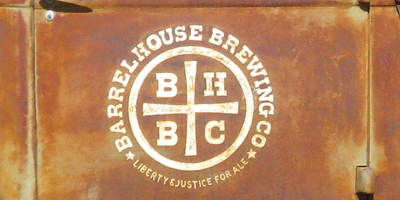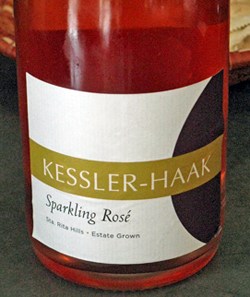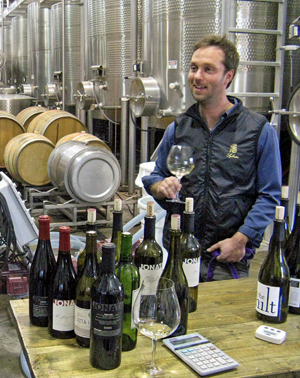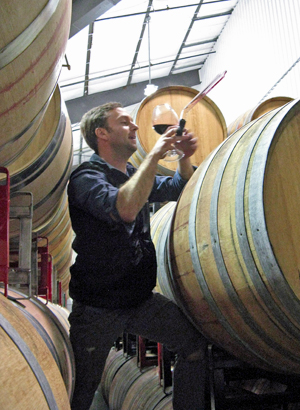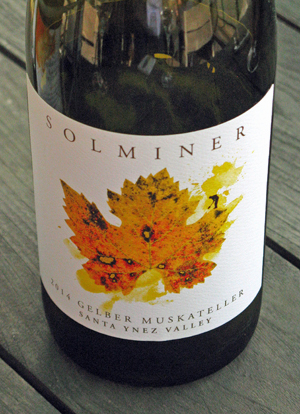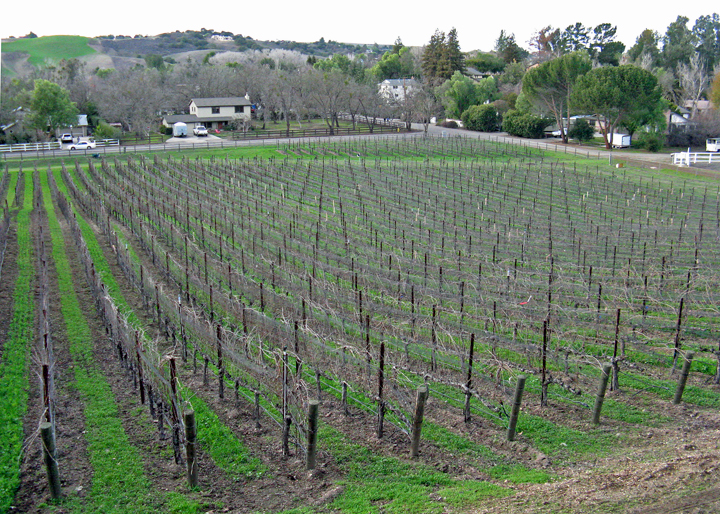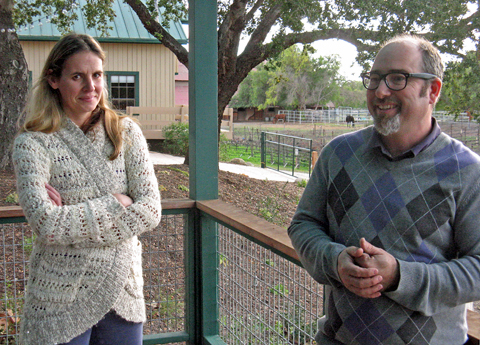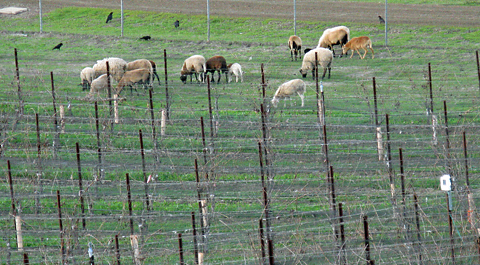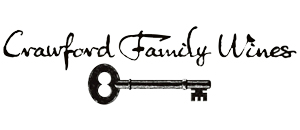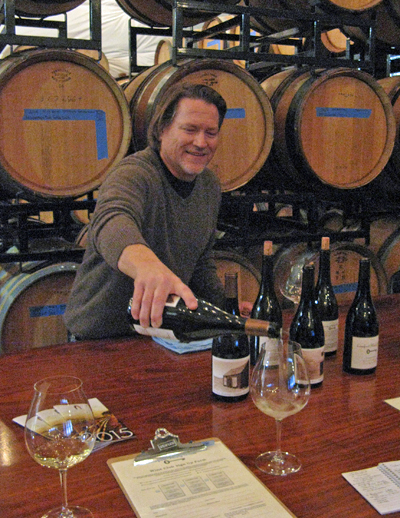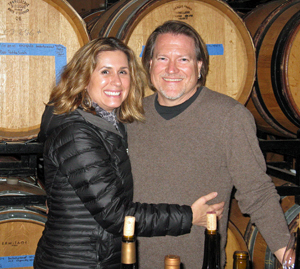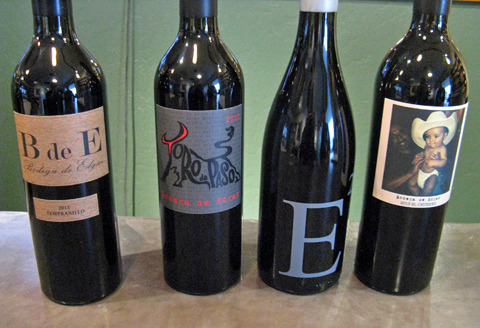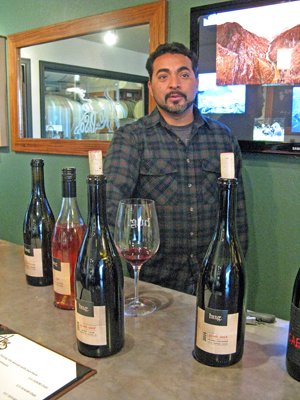Central Coast - January 2016 - Part 2
|
Eric, Michael, Alan and I had a good start to our Central Coast wine tour, visiting five wineries and tasting rooms in the Paso Robles area, and enjoying a visit with friend Sasha Verhage and his family. It was the second day of our tour, and we were all enjoying a late-morning beer at Barrelhouse Brewing Company in Paso's "Tin City" when we realized we needed to get started on our drive south from Paso to our next winery visit, in the Santa Barbara County city of Lompoc. Ironically, Lompoc – which now hosts a number of wineries – was founded in 1974 as a temperance colony. After making the 1½-hour drive south from Paso, we all stopped in Lompoc for a quick bite before heading to our next appointment.
|
| Saturday
- January 16, 2016 |
Kessler-Haak Vineyard and Wines
Tasting Notes: Current Releases |
Kessler-Haak 2013 Chardonnay, Sta. Rita Hills. From estate fruit. Light color, featuring citrus, pear, and spice with touches of butter and vanilla/oak on the nose. Medium-rich texture with a lively mouthfeel and smooth finish.
Kessler-Haak 2012 Brut, Estate, Sta. Rita Hills. From 75% Pinot Noir, 25% Chardonnay. Very light color and just lightly sparkling, with apple, pear, yeast, plus nutty and vanilla/oak undertones. A touch flat on the palate (perhaps just this bottle?) with a dry finish.
Kessler-Haak 2012 Sparkling Rosé, Estate, Sta. Rita Hills. From 100% Pinot Noir. Medium-light salmon/pink color, this was noticeably more sparkling than the previous wine, with aromas of bright strawberry and other red fruit, yeast, and earth. Fine bead with a tasty finish – perhaps a bit less elegant than the Brut but overall quite pleasant.
Kessler-Haak 2010 Pinot Noir, Kessler-Haak Vineyard, Sta. Rita Hills. Medium-light ruby color, this showed black cherry and darker fruit, lots of spice, and sweet oak in the background. Medium-bodied with milder, resolved tannins on the finish.
Kessler-Haak 2011 Pinot Noir, Sta. Rita Hills. From estate fruit. Slightly lighter color than the previous wine, with savory and floral notes along with black cherry fruit and spice. Medium weight with good structure and moderate, chalky tannins on the finish, nice.
Kessler-Haak 2012 Pinot Noir, “Ohana,” Sta. Rita Hills. From estate fruit. Medium ruby color, this displayed riper fruit and a bit more oak and spice on the nose, along with touches of earth and flowers. Richer texture, finishing with moderate tannins – this seems like a candidate for more time in the cellar.
Kessler-Haak 2013 Syrah, Sta. Rita Hills. Sourced from Lafond and Hilltop vineyards. Medium-dark purple, aromas of blackberry, flowers, spice, and a touch of black pepper. Medium-full bodied with a lively and elegant texture and firm tannins, nice.
|
|
We all arrived outside the tasting room of Kessler-Haak at the edge of the Lompoc Wine Ghetto, where we said hello to our friend John Tomasso, a longtime Santa Barbara wine country local. John was joining us for our two afternoon winery appointments that day as well as for dinner. Stepping inside, Dan Kessler was behind the tasting counter to welcome us in. I’d first run across the Kessler-Haak wines at a tasting event in 2013 and I enjoyed the wines quite a bit, so I thought this would be a good opportunity to check out more of their wines.
Dan spent a number of years as an electrical engineer – he has a master’s degree from MIT and worked in the semiconductor field at Hewlett-Packard and for a startup business. During that time, he began making wine at home and planted a small backyard vineyard. Eventually wine became more than just a hobby, and Dan completed the UC Davis Distance Learning program for winemaking. He and his wife Ellen looked for a site where they could grow Pinot Noir, Dan’s favorite variety. They came across a property along Highway 246 just west of noted Clos Pepe Vineyard – it’s located in one of the coolest-climate spots in Sta. Rita Hills, a key feature that drew Dan & Ellen to the site. They were able to purchase the property, and they planted a 30-acre vineyard there in 2005. The first vintage from Kessler-Haak Vineyard was in 2008, and the wines are made at the Lafond Winery facility, where Dan is the assistant winemaker.
The vineyard is planted mostly to seven clones of Pinot Noir, and there are about five acres of Chardonnay plus two acres of Syrah that were grafted over recently from Pinot. The soil at the site is mostly sandy, along with some sandy loam. Dan mentioned that he particularly likes 2A clone Pinot grown in sandy soil. I asked about their groundwater supply in the continuing dry conditions in California, and he told us that this has not been much of an issue at their vineyard. Farming practices are organic although the vineyard is not certified. All but a couple of the Kessler-Haak wines are made from estate fruit, and Dan & Ellen have sold fruit to several other noted local wineries including Brewer-Clifton and Liquid Farm.
Dan started our tasting with a 2013 Chardonnay made from clones 76 and 95. It was barrel-fermented and aged on the lees for about 10 months in about 10% new French oak. Next we tasted a couple of sparkling wines – sparklers are a relatively new project for Kessler-Haak, and we would see over the next couple of days that a number of other Santa Barbara vintners have also started to produce sparkling wines in recent years. Because making traditional Méthode Champenoise wines is a laborious and rather specialized technique, part of the winemaking is sometimes done at other facilities – that’s the case here, where the sparklers are made at Rack & Riddle in Hopland. We tasted a 2012 Brut (75% Pinot Noir / 25% Chardonnay) and a 2012 Sparkling Rosé (100% Pinot) – I preferred the Rosé of these two.
We moved on to Pinot Noirs, and tasted the 2010, from 115, 667, and 777 clones, and the 2011, from 114, 115, 777, and 2A clones, both aged in about 30% new oak. Dan told us that his Pinots are entirely destemmed, and aged for 9-10 months in both French and Hungarian oak. We tried one more Pinot bottling, the 2012 “Ohana” (Hawaiian for “family”), which includes six of the seven Pinot clones planted at vineyard. We finished up with a 2013 Syrah, sourced from Lafond and Hilltop vineyards (Hilltop is across Santa Rosa Road from Lafond), all destemmed, and aged in 30% new oak. The first Kessler-Haak estate Syrah will be from the 2015 vintage. The winery also produces a Dry Riesling sourced from Lafond Vineyard and a Pinot Noir Rosé.
It was good to stop in to taste with Dan at his tasting room to get a broader overview of the Kessler-Haak wines than I’d had before. I’d never tried their sparkling wines or Syrah before, and their “Ohana” Pinot bottling was new to me as well. My favorites included the Sparkling Rosé, 2011 Pinot Noir, and Syrah, but all of the wines were solid. Prices are very reasonable for quality wines from Sta. Rita Hills fruit, ranging from $29 to $40 for the still wines we tasted and a little more for the sparklers. If you’re a fan of wines from this region, the Kessler-Haak wines are worth seeking out.
Jonata / The Hilt
Tasting Notes: Library Wines, & Barrel Samples |
The Hilt 2014 Chardonnay, Sta. Rita Hills. Very light color, with bright citrus aromas along with notes of spice, smoke, and vanilla/oak. Medium weight in the mouth with a slightly chalky mineral character and lively finish, nice.
Jonata 2013 “Flor,” Ballard Canyon. 70% Sauvignon Blanc, 30% Sémillon (co-fermented). Medium-light color, this showed intense grapefruit and fig fruit plus fresh herbs (but not grass) on the nose along with notes of smoke and spice. Rich mouthfeel and a long, smooth finish, quite distinctive.
The Hilt 2014 Pinot Noir, Sta. Rita Hills. Medium ruby color, featuring black cherry and darker fruit, smoke, spice, and tea leaf. Medium-bodied with good structure and moderate tannins.
Jonata 2013 “Fenix,” Ballard Canyon. 65% Merlot, 30% Cabernet Franc, 5% Petit Verdot. Medium purple color, ripe plum and darker berry fruit, herbs, and smoke on the nose. Bold and structured, with a tannic finish that was chalky but not harsh.
Jonata 2006 “La Sangre de Jonata,” Santa Ynez Valley (library wine). 100% Syrah. Medium-dark purple with slight bricking, this displayed savory, meaty aromas along with dark berry fruit, herbs, and smoke. Rich and structured, this finished with big, chewy tannins.
Jonata 2005 “La Sangre de Jonata,” Santa Ynez Valley (library wine). 100% Syrah. Dark color, with gamey and slightly funky notes along with pepper, blackberry, and earth. Showing a bit brighter acidity on the palate than the previous wine and still fairly youthful, with a grippy tannic finish.
Jonata 2013 “La Sangre de Jonata,” Syrah, Ballard Canyon. With about 2-3% Viognier. Dark purple color, this had pretty floral aromas along with blackberry, herbs, and earth. Medium-full bodied with plenty of structure, finishing with moderate but chewy tannins. Amazingly fresh for a bottle that had been open for six days!
The Hilt 2015 Chardonnay, Sanford & Benedict Vineyard (barrel sample). From new barrel. Light straw color, with loads of upfront fruit but not especially oaky, and good acidity on the palate.
The Hilt 2015 Chardonnay, Bien Nacido Vineyard (barrel sample). Grapefruit and herb on the nose, almost Sauvignon Blanc-like, showing a bit less acidity than the previous wine.
The Hilt 2015 Pinot Noir, Sanford & Benedict Vineyard (barrel sample). Mount Eden clone, 100% whole-cluster fermented. Light ruby color, intense strawberry and rhubarb aromas with floral and herbal notes but not stemmy, quite structured on the palate.
The Hilt 2015 Pinot Noir, Sanford & Benedict Vineyard (barrel sample). Mount Eden clone, 30% whole-cluster fermented. A bit reductive, less intense aromatics than the previous wine with a slightly darker fruit profile, and moderate tannin.
Jonata 2015 Syrah, Ballard Canyon (barrel sample). Medium-dark purple, floral, meaty, smoky, with a hint of coffee on the nose, medium full-bodied with fairly big tannins.
Jonata 2015 Petite Sirah, Ballard Canyon (barrel sample). Very dark color, concentrated blueberry aromas plus pepper and spice, huge structure with tannins that wouldn’t let go!
|
|
We drove east to Buellton for our last appointment of the day, with winemaker Matt Dees of sister labels Jonata and The Hilt. We all arrived outside the facility but we weren’t sure Matt was there so we waited outside for a bit. Turned out that he was inside the whole time, and after a few minutes he spotted us and welcomed us in. I’d been there with Eric back in 2006 and Eric had stopped there once more the following year so by this time we were well overdue for a return visit.
Venture capitalist Charles Banks (who is no longer involved in the project) was part of the group who purchased the 586-acre Jonata property in Ballard Canyon in 2000. Real estate developer and pro sports team owner Stan Kroenke now heads up Jonata and its two related labels. The name comes from an 1845 Spanish land grant that once covered a much larger area, Rancho San Carlos de Jonata. After planting an 84-acre vineyard on the area’s sandy soil, the first harvest came in 2004. Both white and red Bordeaux grape varieties take up much of the vineyard, with Syrah, Petite Sirah, and Sangiovese among other varieties planted there. The Jonata wines are all made entirely from estate-grown fruit. Current releases include “Flor” (Sauvignon Blanc/Sémillon), “El Desafio de Jonata” (Cabernet Sauvignon-based blend), “El Alma de Jonata” (Cabernet Franc-based blend), “Fenix” (Merlot-based blend), “Fuerza” (Petit Verdot), “Tierra” (Sangiovese), “La Sangre de Jonata” (Syrah), “Todos” (Syrah-based blend), and “La Miel de Jonata” (Sémillon/Sauvignon Blanc dessert wine).
There was some non-estate Pinot Noir called “La Poesía de Jonata” produced for a few years in the mid-2000s, but this was replaced in 2008 by an entirely new label, The Hilt. The Hilt focuses exclusively on Chardonnay and Pinot Noir sourced from top Sta. Rita Hills vineyards. They’ve produced two bottlings each vintage for both varieties – a more restrained style called “The Old Guard” and a bolder style called “The Vanguard.” In mid-2014 The Hilt made a big splash by purchasing the large Salsipuedes site – home to Radian & Bentrock vineyards – on the western edge of Sta. Rita Hills. The Salsipuedes vineyards currently produce around 500 tons of fruit, with The Hilt keeping about 100 tons while the rest is sold to other vintners.
A third related label is The Paring, with its first releases in 2007. Value-priced ($20-25) and aimed at the restaurant wine market as well as to consumers, The Paring’s line-up includes Rosé, Chardonnay, Pinot Noir, Syrah, plus white and red blends. It’s tough to find Santa Barbara County wines of The Paring’s pedigree in that price range.
Matt has been the Jonata winemaker from the start, and he’s continued to make their wines as well as those from The Hilt and The Paring. Originally from Kansas, Matt earned a degree in soil science from the University of Vermont. He’s worked at wineries as far-flung as Craggy Range in New Zealand and Staglin in Napa Valley – Andy Erickson, whom Matt worked with there, recommended him to Jonata’s owners. Famed wine consultant Michel Rolland is another member of the Jonata team, and Matt had many words of praise for vineyard manager Ruben Solorzano – Matt calls him “the vine whisperer.”
Matt led us back into the winery, and we gathered around a table that was full of opened bottles from recent tastings, so it was easy to start right in! We went through an assortment of wines from both Jonata and The Hilt. Matt poured us two wines from The Hilt – new 2014 Sta. Rita Hills Chardonnay and Pinot bottlings without the “Old Guard” or “Vanguard” designations. The Chardonnay was made entirely in stainless steel and neutral oak, with super-low (<3.15) pH, and the Pinot includes fruit from Salsipuedes and Sanford & Benedict. The Jonata 2013 “Flor” and “Fenix” were real stunners – very distinctive and not what you’d expect for wines based on Sauvignon Blanc and Merlot. We also tasted a couple of older “La Sangre de Jonata” vintages (wow, the 2006 still had huge tannins!) and a 2013 "La Sangre de Jonata" that was tasting amazingly fresh and vibrant despite having been opened six days earlier.
We talked with Matt for a short time about his winemaking, and he told us that it hasn’t changed much over the years. He favors cool ferments and limited extraction – a key for the wines since fruit from Jonata’s estate vineyard demands careful tannin management. Matt is using more whole clusters than in the past, though, and sorts the fruit less than he used to – he said that his goal is to express the vineyard character in the wines.
Matt wanted to pull some barrel samples for us, and how could we refuse? We tasted a couple of 2015 Chardonnays, including one from 44-year old vines at Bien Nacido Vineyard, compared two barrels of 2015 Sanford & Benedict Vineyard Pinot with differing amounts of whole-cluster fermentation, and finished up with a 2015 Jonata Syrah and a Petite Sirah. The Petite Sirah was huge, and Matt was not sure yet what wine it will go into. Matt told us that he’s also making a very small amount of sparkling wine at the winery – should be interesting to try that when it’s finished. Matt’s dog Otis provided us with some amusement during our visit and especially while we were sampling from barrels. Otis had to wear one of those cone-shaped collars for awhile and was not having the easiest time maneuvering around barrels and winery equipment, though he didn’t seem terribly annoyed with his situation – I think he enjoyed our company.
We had a great visit with Matt, and it was easy to see that he was really enjoying it too. Jonata has been a pioneer for high-end Bordeaux-style wines in Santa Barbara County, a region that has not been especially known for Bordeaux varieties over the years. While the Jonata wines tend to be big and structured, Matt showed that he has a fine touch with more delicate varieties like Chardonnay and Pinot Noir under The Hilt label too. Favorites included The Hilt Chardonnay, and Jonata “Flor” and “Fenix” – several barrel samples showed plenty of promise as well, while the library wines are developing nicely. The wines of Jonata and The Hilt are pricey but they’re highly sought-after – their high quality was unmistakable during our tasting. These wines showcase a range of grape varieties and styles, and they’re among the most distinctive bottlings from Santa Barbara County.
Goodland / Mail Road / Kimsey
Tasting Notes: Current Releases |
Goodland 2014 “Happy Canyon White,” Happy Canyon. 100% Sauvignon Blanc. Light straw color, with classic bright grapefruit and fresh herb aromas. Vibrant acidity on the palate, with a crisp and tasty finish, nice.
Mail Road 2013 Chardonnay, Mt. Carmel Vineyard, Sta. Rita Hills. Light color, featuring stone fruit, spice, and vanilla/oak on the nose. Fairly rich and creamy texture balanced with juicy acidity, and a long, clean finish, nice.
Mail Road 2012 Pinot Noir, “Blocks 2, 3 & 5,” Mt. Carmel Vineyard, Sta. Rita Hills. Medium ruby color, this was herbal and savory, with ripe black cherry and raspberry fruit plus spice and floral notes in support. Medium-bodied with fine, moderate tannins – the components could use more time to integrate but this develop very nicely in the next few years.
Kimsey 2012 Syrah, Ballard Canyon. With about 2-3% Viognier. Medium-dark purple, this ripe displayed black fruits, mocha, with notes of flowers and herbs. Medium-full bodied with fine structure and firm, chalky tannins – very tasty now and should age well too.
|
|
Before our visit with Matt Dees at Jonata, we’d mentioned to him that we were interested in checking out some of the other wines that he’s involved in making, so he led us to another facility just a short distance away to taste a few bottles of those wines. It was a tight space, filled with pallets of wine, but we managed to squeeze in to get tastes of the wines that Matt poured for us.
Goodland is a project launched in 2011 that Matt shares with three friends – vineyard manager Ruben Solorzano and fellow winemakers Chris Snowden and Dave Potter. They have an interesting concept for labeling the wines, based on the European model of emphasizing the region rather than the grape variety, so the wines are simply labeled by appellation and "red" or "white." Some are varietal bottlings and others are blends. There are Bordeaux varieties for the Happy Canyon bottlings, Burgundian varieties for Sta. Rita Hills and Santa Maria Valley, Rhône varieties for Ballard Canyon, and a little of everything for Santa Ynez Valley. We tasted the very nice 2014 “Happy Canyon White” – 100% Sauvignon Blanc with no malolactic fermentation.
Mail Road is a new label to showcase an established and highly-regarded site, Mt. Carmel Vineyard in Sta. Rita Hills. The vineyard is high up, on a steep south-facing slope – and naturally, near the end of Mail Road. Planted in 1990 by Ron Piazza with own-rooted heritage selection Chardonnay and Pinot Noir, Brewer-Clifton later helped develop the vineyard, and the fruit went to them as well as to Babcock, Longoria, and Au Bon Climat. More recently, Ron partnered with local ice cream company owner Michael Palmer to form the Mail Road label, and now they are the only producer getting Mt. Carmel Vineyard fruit. Matt is making their wines, and the initial releases have been a big hit with wine critics. Current releases include a Chardonnay, Pinot, and separate block-designated Pinot. We tasted the 2013 Chardonnay (made in 40% new French oak and 30% each neutral oak and stainless steel) and the 2012 “Blocks 2, 3 & 5” Pinot Noir (100% destemmed, aged in 1/3 new and 2/3 neutral French oak). Production of all the Mail Road wines is very limited.
Our last wine of the day was from the Kimsey label. The 22-acre Kimsey Vineyard in Ballard Canyon was planted in 2008 by Bill & Nancy Kimsey, mostly to Syrah plus a little Grenache, Viognier and Roussanne. Ruben Solorzano farms the vineyard and Matt makes the wine. Kimsey sells fruit to a few other producers as well. Matt noted that there are lots of different clones to work with at the vineyard. Current 2012 releases include a white blend (20% Viognier and 80% Roussanne), Grenache, and Syrah – all but the Syrah are tiny production. We tasted the Syrah with Matt – it was fermented with about 10% whole clusters and 3% Viognier.
Tasting these wines was a fun way to wrap up our visit with Matt. The Goodland, Mail Road, and Kimsey wines demonstrated more sides of his winemaking skill, and really every one of the wines we tried was a standout or has the potential to be one with a little more time. Matt is doing a great job with these projects – the wines showcase a range of grape varieties and styles, and there should be something of interest for nearly everyone.
We had a short trip to our motel, the Quality Inn in Buellton. We didn’t have a lot of time to spare after checking in, and we piled into Eric’s car for the drive to our dinner destination at The Ballard Inn Restaurant, in the tiny town of Ballard a few miles south of Los Olivos. John Tomasso joined us for dinner, and we brought some older wines to share. John often brings a Riesling, and this one – a 2005 Fritz Haag Brauneberger Juffer-Sonnenuhr Riesling Spätlese – was a winner. A couple of 2004 California Pinot Noirs – both from highly-regarded producers – didn’t fare so well, though. That wasn’t an easy vintage of Pinot in most the state, and these had not aged as well as we’d hoped. Regardless of those wine disappointments, I’m rarely disappointed with The Ballard Inn – it’s been a longtime favorite for dinner in Santa Barbara wine country for many years, and the food (from Chef Budi Kazali) and service continue to be among the best in the area.
The following morning, we got ready for the third day of our Central Coast wine tour, focusing entirely on Santa Barbara County for this day and the next. After lots of time on the road the first two days, there was less driving needed over the next couple of days so we were hoping our schedule would allow for a more relaxing pace…although I’ve learned over the years of wine touring that things don’t always work out that way!
We visited several “Pioneers of Santa Barbara County Wine” over this day and the next, and those visits are covered in a separate Grape-Nutz report of that name. But we mixed those in with a couple of other stops in Santa Barbara County plus one more back in Paso Robles – all of these focusing on newer and noteworthy wineries.
Sunday morning was clear and bright, and it looked like we were in for a day of sunny and warm weather. Our motel stay in Buellton included breakfast…ah, nothing like a motel breakfast! And although the choices were pretty much what you’d expect, the food actually wasn’t bad at all by motel breakfast standards. Since Eric’s car has a roomier back seat than mine does, he volunteered to drive us for the day. After a couple of “Pioneer” visits earlier in the day, we headed out from Lompoc for two more stops on Sunday.
| Sunday
- January 17, 2016 |
Solminer Wines
Tasting Notes: Current Releases & Upcoming Releases |
Solminer 2014 Gelber Muskateller, Santa Ynez Valley. Very light color, displaying floral aromas along with lychee and spice, similar aromatics to a Gewürztraminer. Medium-light bodied with a pleasant texture and tasty finish – less “perfumey” than most Muscats and very distinctive.
Solminer 2014 Grüner Veltliner, Santa Ynez Valley. Very light straw color, this had green apple and citrus on the nose with touches of fresh herbs and spice. A bit more weight on the palate than the previous wine, with bright acidity and a clean finish, nice.
Solminer 2014 Dry Riesling, Kick-On Ranch, Santa Barbara County. Very light color, with subtle stone fruit and petrol aromas, plus a slight floral note. Medium-bodied with vibrant acidity and a fresh finish.
Solminer 2014 “Linus” Rosé, deLanda Vineyard, Santa Ynez Valley. Very light salmon/pink color, showing watermelon and red berry fruit along with a stony mineral note. Zippy acidity with a crisp finish, very pleasant.
Solminer 2014 “Rubellite” Syrah, Santa Ynez Valley. 90% Syrah, 9% Grenache, 1% Riesling. Medium-light ruby color, this was earthy and savory, with bright strawberry fruit and a touch of spice. Medium-light bodied, this was light and lively on the palate with a clean, refreshing finish, nice.
Solminer 2012 “Full Moon” Syrah Reserve, deLanda Vineyard, Santa Ynez Valley. Medium-light purple, featuring intense raspberry and plum fruit along with floral, savory, and saline notes. Medium-bodied with bright acidity and fine tannins, nice.
Solminer 2014 “Nebullite” Sparkling Syrah, deLanda Vineyard, Santa Ynez Valley. Lighter ruby color, with bright black cherry and raspberry fruit along with earth and herb notes. Lightly bubbly and very pleasant, an easy-drinking and refreshing sparkler not unlike a Lambrusco.
Solminer 2014 Blaufränkisch, deLanda Vineyard, Santa Ynez Valley (pre-release). Medium purple, this had aromas of earthy and savory dark berry fruit. Medium weight and with fine acidity, it seemed a bit tight from its recent bottling, but it’s intriguing and shows potential.
|
|
We were a little late by the time we left Lompoc, and one wrong turn along the way (due to some bad navigation instructions from me) set us back few more minutes, but eventually we arrived at our next appointment. Just a short distance from “downtown” Los Olivos, we proceeded up the short hillside drive to the home of Solminer Wines proprietors David and Anna deLaski. I’d been intrigued by the potential for making Grüner Veltliner in Santa Barbara County since learning over the past 5-6 years that a small number of local vintners were working with the variety. I’d made an appointment to visit with one of them on my previous visit to the area but the winemaker decided at the last minute not to see us…oh well. But I’d heard from friend and colleague Tom Hill about another producer in the area, Solminer. So I was delighted to be able to arrange a visit with David and Anna to check out their vineyard and wines.
We met David and Anna by their house, and we also briefly met their young son Linus and David’s two older boys Zevin and Dexter. Walking over to their porch, we had a lovely view across their small vineyard and beyond to the hills west of Los Olivos. As we enjoyed the late-afternoon sun, David and Anna told us a bit about their backgrounds and how they started growing grapes and making wine. The couple met in 2009 while both were living in Los Angeles, where David had been active in film and electronic music production. He’s run his own small record label (Ball of Waxx) for over 15 years – it’s still active but Solminer is his main focus these days. Anna grew up in Austria near the Wachau wine region, and has a background working with furniture manufacturers on sustainable forestry practices for their company’s wood. So the couple brought creativity and environmental awareness to the table when they decided to make a change in their lives and move to Santa Barbara wine country.
The beauty of the area had already exerted a pull on them, but while David’s father collected and drank fine wines, David never had a serious interest himself until he and Anna fell for the Austrian grape varieties of her original home. Without any real background in making wine, David and Anna needed guidance, and a big break came when they were able to recruit Steve Clifton to help in both the vineyard and winery. Steve has worked with lots of grape varieties over the years, including Burgundian varieties at Brewer-Clifton and Italian ones at Palmina, and he was interested in helping David and Anna with some different – and obscure for California – grapes.
David and Anna had actually not intended to buy their own vineyard, but when they found the property in Los Olivos and Steve agreed to help them, they decided to go for it and they moved there in 2012. There was already a 2-acre Syrah vineyard on the northwest-facing hillside, with fruit that had gone to Andrew Murray in the past. Steve helped them get the vineyard in better shape and to work with them to graft over about 1/2 acre to Grüner Veltliner and 1/3 acre to Blaufränkisch. From the start, David and Anna have farmed the vineyard organically – they received organic certification in 2014 – and they’ve been working with biodynamic farming practices as well. While an increasing number of vineyards are farmed organically, only a portion of them are certified due to the certification process and cost, but David and Anna feel the certification is particularly important for them. Being new and little-known, it’s a mark of credibility that shows others that they’re serious about the way they’re farming their vines. Just the day before our visit, a friend brought over a small flock of sheep that will stay at the vineyard until budbreak – one of the sheep had a lamb earlier that day and another lamb arrived during our visit! David and Anna have named their small vineyard “deLanda,” which combines their names.
We sat around a table on the porch, and David and Anna started pouring us their latest Solminer wines. The Solminer name comes from the idea of “mining the sun” (and also the soul) of the Central Coast. Our first wine was 2014 Gelber Muskateller, a dry Muscat from Palmina’s nearby Honea Vineyard. It’s bone dry and was made in neutral oak, with no lees-stirring. I loved this wine, one of the most distinctive Muscats I’ve tried from California. The Solminer winemaking in general is minimalist, with no yeast additions. David said that some of their whites go through malolactic fermentation and some don’t – he and Anna prefer not to have any set rules for making the wines but to let them express the fruit for each vineyard and vintage.
Next up was 2014 Grüner Veltliner. With fruit sourced 50% each from their own vineyard and from John Sebastiano Vineyard, it was made in neutral oak and stainless steel, and weighs in at just 11.7% alcohol. David and Anna said they’re not intentionally aiming to make lower-alcohol wines, but just trying to pick fruit to make the wines in a style that they enjoy – harvest decisions are made mainly on acidity. They noted that Grüner is made in a variety of styles, and that they’re making theirs in a more serious, ageable style. Anna mentioned that it’s a versatile wine that can pair with difficult-to-match foods such as asparagus. Our last white was 2014 Dry Riesling from Kick-On Ranch in Los Alamos Valley, from 10-year old vines planted in sandy soil. David told us that the most recent vintage of both the Grüner and the Riesling had some skin contact before pressing. All three white wines were winners.
Although Syrah was a variety they had not originally planned to work with when they decided to make wine, David and Anna needed to make good use of the vines that were already at their own vineyard! What they’ve done is to create a fascinating array of different and distinctive expressions of Syrah. The 2014 “Linus” Rosé is farmed specifically for Rosé and picked early – always a good move for Rosé in my book and essential to make a pleasant and light Syrah-based Rosé such as this one. We next tried the 2014 “Rubellite,” named for a ruby-red mineral. Mostly early-picked Syrah (same time as for the Rosé), it also includes some Grenache and a small amount of Riesling, and was aged for 6 months in neutral oak. Light and fresh, several of us remarked that it reminded us more of a good Beaujolais than a Syrah.
The 2012 “Full Moon” Reserve Syrah was more “Syrah-like.” From entirely destemmed fruit, it underwent about a four-day cold-soak followed by 21-day maceration and 16-month barrel-aging. David said there was some new oak used in the 2012 vintage but none for more recent vintages. One more Syrah-based wine followed – a small amount of the “Rubellite” blend was made into sparkling 2014 “Nebullite”, made by the traditional Méthode Champenoise. This was nothing remotely like an Aussie sparkling Shiraz, and more akin to a light and refreshing Lambrusco. David brought out one last wine for us to taste. Bottled just two days before our visit, it was 2014 Blaufränkisch, the first from their estate vineyard – it will be released in late spring or early summer.
All of the Solminer wines are made at Steve and Chrystal Clifton’s Palmina facility, and David and Anna are gradually taking on a greater role in the winery. The labels are quite distinctive, and they’re using Diam 5 cork closures for the wines. 2012 was the first vintage, and production remains small, with a goal of growing to around 2,000 cases per year. David and Anna told us that they have a 2015 Pinot Noir in barrel, sourced from Duvarita Vineyard just to the west of the Sta. Rita Hills AVA near Lompoc. Originally called Presidio Vineyard, it had been farmed biodynamically in its earlier years and it’s being returned to that now. As far as future plans for their own vineyard, David and Anna are thinking about adding some St. Laurent vines, a variety I’d certainly like to see more of in California.
Visiting with David and Anna at Solminer was certainly one of the highlights of our Central Coast trip. Of course it’s always relaxing to sit on a porch overlooking a vineyard in a beautiful setting, and if only for that it would have been fun to stay a little longer – we would have gotten a closer look at the newborn lamb in the vineyard. Plus David and Anna were terrific hosts – friendly, generous, humble, and with an interesting story to tell. But on top of all that, the Solminer wines were outstanding across the board – there wasn’t a single one of them that I didn’t enjoy greatly. The wines were so different and so distinctive – probably the best group of Austrian-style wines from California that I've tasted, and some creative and compelling takes on Syrah. It’s tough to pick favorites among such a strong group of wines, but I particularly liked the Gelber Muskateller, Grüner Veltliner, and the “Rubellite” and “Full Moon” Syrahs. Prices are hard to beat, too, with only two of the current wines selling for over $30. David and Anna seem genuinely happy to be where they are – both in Los Olivos and at this new stage in their lives – with their kids and dog playing in the vineyard, a world away from busy Los Angeles. I think there’s a great future ahead for Solminer, and I’m excited to see where David and Anna take their wines from here.
Crawford Family Wines
Tasting Notes: Current Releases |
Crawford Family 2013 Chardonnay, “Tin Shack,” Rita’s Crown Vineyard, Sta. Rita Hills. Very light color, this displayed bright citrus and apple aromas along with lemonpeel and spice. Medium-light bodied with a lively mouthfeel and finish, nice.
Crawford Family 2013 Pinot Noir, “Walk Slow,” Sta. Rita Hills. Medium-light ruby color, with plum and darker berry fruit, earth, spice, and herb/stem notes. Medium-bodied with fine tannins and a stony mineral note on the finish.
Crawford Family 2013 Pinot Noir, Radian Vineyard, Sta. Rita Hills. Medium-light color, this was brighter and more floral, with black cherry, spice, and tea leaf aromas. Medium weight on the palate with lively acidity and moderate, slightly chalky tannins, nice.
Crawford Family 2013 “Second Street Cuvée,” Ballard Canyon. 60% Syrah, 30% Grenache, 10% Mourvèdre. Medium purple color, featuring ripe plum, earth, some gamy notes, with lots of spice and a touch of black pepper on the nose. Medium-bodied with good acidity and moderate tannins.
Crawford Family 2014 Syrah, Zotovich Vineyard, Sta. Rita Hills. Medium-dark color, this showed lots of floral character along with blackberry fruit, pepper, and savory, meaty notes. Medium-full bodied and structured, finishing with firm tannins – very tasty now for its purity of fruit but should age nicely.
|
|
We were running a bit late to our final winery appointment of the day at Crawford Family Wines, but fortunately we were able to call ahead to proprietors Mark and Wendy Horvath to let them know. Their winery is in Buellton, not much more than a stone’s throw from our motel there. They moved to this facility about two years ago and opened their tasting room in fall 2015. The Crawford Family label is fairly new, but both Mark and Wendy have been on the Santa Barbara County wine scene for a number of years.
Mark originally got into wine through his friend Master Sommelier Emmanuel Kimiji (he grew up in Spain and is now the owner of Miura Vineyards) and he decided to refocus his energy on making wine. Mark and Wendy moved to Sonoma County, where Mark took a job at Carmenet Winery in 1997. While there, Mark took wine courses through the UC Davis extension program and met several aspiring Santa Barbara County winemakers – their enthusiasm led Mark and Wendy to explore the region and they decided to move there when Mark was offered the position of assistant winemaker at Babcock Winery. Mark spent five years working with Bryan Babcock, eventually taking charge of the winemaking duties there. Wendy’s background is in the restaurant business – she worked at the famed French Laundry in Yountville and later at Santa Barbara’s Wine Cask. She’s also worked for a wine distributor.
Mark started his first wine label in 2000 with his friend Kenneth “Joey” Gummere. Under their Kenneth-Crawford label, they produced some notable Santa Barbara Pinot Noir, Syrah and Grenache. I’d visited them in 2010 with Eric and a few other friends. The two decided to part ways, and Joey now has his own Transcendence label. Mark launched the Crawford Family label in 2011 – Crawford is his mother’s maiden name and his middle name. The focus is mainly on Pinot Noir (and a little Chardonnay) from Sta. Rita Hills along with Rhône varieties mostly from Ballard Canyon. Vineyard sources include Babcock, Bentrock, Radian, Rita’s Crown, Tierra Alta, and Zotovich. Production is small but growing, from about 600 cases in 2012 up to around 1,000 cases now.
In addition to the Crawford Family Wines project, Mark is also the winemaker for Tres Hermanas Winery along Foxen Canyon Road. He works with quite a few interesting grape varieties there, many of them Italian, including Malvasia Bianca, Dolcetto, Refosco, and Nebbiolo. Wendy also has a “day job” – she’s a wine broker specializing in small Central Coast producers.
Wendy needed to attend to some other work at the winery so we sat at a table in front of a stack of barrels as Mark started us off on tasting current Crawford Family releases. We started with 2013 “Tin Shack” Chardonnay, sourced from Rita’s Crown Vineyard, fermented in stainless steel and aged 11 months in neutral oak. Mark told us that he neither inoculates for nor inhibits malolactic fermentation in the Chardonnay, and this one went through about 60%. This is the winery’s lone Chardonnay, and Mark said they’ll probably stick with just the one bottling for now. The distinctive photo on this label and on a couple of other Crawford Family labels were taken by Mark’s brother-in-law, who is a photographer. The label photos feature old doorways, which have fascinated Mark and Wendy since their honeymoon in Europe.
We proceeded to Pinot Noir, starting with the 2013 “Walk Slow.” Sourced from 50% each Bentrock and Radian vineyards and including 667, 777, 828 clones, the fruit was fermented with about 30% whole clusters and aged in 30% new oak. Mark said that he is aiming to dial in structure for each Pinot by his choice of oak and amount of whole-cluster fermentation. The 2013 Radian Vineyard Pinot was fermented with just a small percentage of whole clusters and was aged in neutral barrels.
Moving on to Rhône varieties, we tasted the 2013 “Second Street Cuvée,” sourced mostly from Tierra Alta Vineyard. Made with entirely destemmed fruit and aged 11 months in neutral oak, Mark said the goal is for a Côtes du Rhône style wine. He also told us that they will turn “Second Street” (where the winery is located in Buellton) into a second label for Crawford Family, at a lower price point than their other wines. Our final wine was the 2014 Zotovich Vineyard Syrah – this was all from destemmed fruit (the 2015 will be 25% whole-cluster) they made just two neutral barrels of this wine. Crawford Family makes a couple of additional Pinot bottlings as well as a Rosé, and Mark said that he made an Albariño in 2015 that will come out under the Second Street label.
I have to admit that I’d forgotten how good Mark Horvath’s wines can be, so this was the perfect opportunity to revisit them. I got the sense that both Mark and Wendy are very happy to be running their own small winery now, and the Crawford Family wines we tasted showed the focus that they’ve put into them. I thought the standouts of our tasting included the “Tin Shack” Chardonnay, Radian Vineyard Pinot, and Zotovich Vineyard Syrah, but the other wines we tasted were quite good too. Prices are reasonable for wines of this quality from the region. The winery’s logo and the labels on their single-vineyard wines feature an image of a skeleton key. Mark and Wendy explained that their son loves skeleton keys and collects them. They realized that the key is an apt symbol for their wines, as you unlock the door to a new adventure and perhaps a hidden treasure! The Crawford Family Wines key is certainly one to pick up.
It was good that our motel was very close by, since our tasting at Crawford Family ran later than expected and we needed to head out for dinner quickly. Our dining choice for the evening was Trattoria Grappolo in Santa Ynez, a few miles east of Buellton. I’d been there a couple of times before (I first met noted growers / vintners Peter Cargasacchi and James Ontiveros at a dinner there with Brian Loring back in late 2002) but it had been awhile since I’d last eaten at Grappolo. Our group was seated in a pleasant enclosed porch area, and once again we brought some older wines to open with dinner. And just as at our dinner the previous night, the food was more enjoyable than the wines, this time a couple of 2005 Pinots. The wines weren’t bad, but given the reputation of the producers, we’d expected more. I was very pleased with my meal at Grappolo, and I’m sure I’ll be back there again sooner rather than later.
We spent all of Monday visiting Santa Barbara wine pioneers, and we were all headed home on Tuesday – I’ll skip ahead to that morning. Eric and Michael wanted to get a fairly early start on their drive home to beat traffic as they headed through the Los Angeles area, while Alan and I had scheduled one final winery appointment in Paso Robles on our way back to the Bay Area. Eric had the excellent suggestion that we skip the motel fare that morning and gather for breakfast at Mother Hubbard’s Restaurant in Buellton before hitting the road. It was another morning of dark skies and light showers but we managed to avoid the rain as we packed up our cars. Mother Hubbard’s was just down the street from our motel and we parked right in front. We all enjoyed a hearty and relaxing breakfast there before parting ways. The skies looked more and more threatening as Alan and I drove north, and we hit heavy rain between San Luis Obispo and Paso Robles.
| Tuesday
- January 19, 2016 |
Bodega de Edgar / Hug Cellars
Tasting Notes: Current Releases |
Hug 2014 Chardonnay, Rancho Viñedo, Santa Maria Valley. Lighter color, this had ripe pear and apple fruit, spice, and vanilla/oak on the nose. Medium-rich texture on the palate with a fairly smooth finish.
Hug 2014 Rosé, Rancho Ontiveros, Santa Maria Valley. Rosé of Pinot Noir. Medium-light salmon/pink color, displaying cranberry and strawberry fruit with floral undertones. Medium-light bodied with a slightly chalky mineral mouthfeel and finish.
Hug 2014 Pinot Noir, Cedar Lane Vineyard, Monterey County. Medium ruby color, with bright red fruits, earth, herbs, and a touch of baking spice. Medium weight, this had a lively mouthfeel and clean finish with fine tannins, nice.
Hug 2014 Pinot Noir, Rancho Ontiveros, Santa Maria Valley. Slightly darker color, this showed a darker fruit profile with notes of dried herbs, spice, and pencilly oak. Bigger and more structured on the palate, with a grippy finish – has potential but needs time in the cellar.
Hug 2011 “el Maestro,” Central Coast. Open for a few days, this seemed a little tired and picking up some volatile notes, but it still had plenty of bright strawberry fruit and spice character. Medium-bodied with a fairly big structure and chewy tannins.
Bodega de Edgar 2013 Garnacha, Central Coast. Medium-light color, very aromatic with ripe red fruit, flowers, and herbs. Medium weight with a lively mouthfeel and milder tannins, nice.
Bodega de Edgar 2013 Mourvèdre, Central Coast. Medium purple, this was savory, with herbal and slightly briny aromas along with plum and black cherry fruit and earth. Medium-bodied with good structure and moderate tannins.
Bodega de Edgar 2013 Tempranillo, Central Coast. Medium-dark color, displaying American oak vanilla on the nose, plus darker fruit, herbs, smoke, and earth. Big and structured, with a grippy tannic finish.
Bodega de Edgar 2007 Tempranillo, French Camp Vineyard, Paso Robles. Medium purple color, with ripe red fruits, earth, and spice on the nose. Medium-full bodied, the big tannins sneaked up on the finish – this seemed remarkably youthful.
Bodega de Edgar 2012 “Toro de Paso,” Central Coast. 70% Tempranillo, 20% Grenache, 10% Cabernet Sauvignon. Medium-dark purple, this had aromas of higher-toned red fruits, spice, and sweet oak. Fairly full-bodied with plenty of structure, finishing with big, chewy tannins.
Bodega de Edgar 2013 “E-Squared,” Central Coast. 50% Syrah, 50% Grenache. Medium purple color, featuring intense floral and upfront black fruit aromas along with notes of spice and pepper. Rich but lively, with surprisingly refined tannins, nice.
Bodega de Edgar 2013 “El Chunker,” Central Coast. 40% Merlot, 40% Syrah, 10% Tempranillo, 10% Cabernet Sauvignon. Medium-dark purple, with lots of ripe plum and darker berry fruit, anise, mocha, and dried herb/tobacco on the nose. Big and structured, with very grippy tannins on the finish – the structure of this wine should carry it for many years.
|
|
Alan and I arrived in Paso Robles just as the rain was starting to let up, and we soon pulled up in front of the winery and tasting room of Bodega de Edgar and Hug Cellars, located in a small cluster of industrial buildings on the east edge of town. I first met proprietor Edgar Torres some years ago when he was the assistant at Hug Cellars, and I’ve followed his own Bodega de Edgar label, particularly his wines made from Spanish grape varieties. But it had been a few years since I’d checked in so I figured this would be a good opportunity to do so.
Born in Michoacán, Mexico, Edgar has lived on the Central Coast since he was a boy. He developed a love of fine wine while working as a waiter in Paso Robles’ well-known Villa Creek Restaurant, and then learned about winemaking on the job as a “cellar rat” at the old Garretson Wine Company, which was located right next door to his current winery. Edgar made the short jump over to Hug Cellars – in the same space where Edgar makes his wine now – in 2005, and he stayed there assisting Augie and Raquel Hug for about four years. In 2007, he launched his own Bodega de Edgar label. Edgar (apparently not in favor of moving too far for work!) moved on to work for McPrice Myers / Barrel 27, who had taken over the former Garretson space next door. He continued working there until 2015, and is now focusing his energy into his own label.
But his Bodega de Edgar label is actually not the only winery that Edgar is focused on. Starting in late 2014, Augie and Raquel Hug decided to retire from the wine business after 20 years. Edgar, who’d always maintained a close relationship with them, wanted to keep the Hug Cellars label going, and he purchased their inventory and equipment as well as taking over their winery and tasting room space. Recently, Edgar opened a second tasting room location at the old Alta Colina space at Villicana Winery along Adelaida Road. While Alan and I were visiting with Edgar, he showed us some photos of ongoing progress for renovation and expansion to the tasting room there.
Edgar started us off on tasting some current 2014 Hug Cellars releases. He’s updated the label design and is in the process of refocusing the direction of the wines, changing most vineyard sources other than Rancho Ontiveros in Santa Maria Valley. Our first Hug wine was a Chardonnay from Rancho Viñedo – located not far from Bien Nacido Vineyard in Santa Maria Valley, James Ontiveros is farming the vines there. The Rancho Ontiveros Vineyard Rosé was made from one barrel of saignéed Pinot Noir. Cedar Lane in Monterey County has been a familiar vineyard source for Hug over the years, and the 2014 Pinot was made with 30% whole-cluster fermentation and aged in neutral puncheons. The bolder Rancho Ontiveros Pinot Noir was fermented with 50% whole clusters and aged in 50% new oak. Edgar also poured us a 2011 “el Maestro” Grenache – open for a few days, it was tasting a little tired but it still had plenty of bright fruit.
Edgar told us that upcoming Hug releases will include Larner Vineyard Viognier from Ballard Canyon, Shadow Canyon Vineyard Syrah from York Mountain, and both Zinfandel and a GSM blend from Clevenger Vineyard in Paso’s new Willow Creek appellation. Edgar is also getting Pinot Noir for Hug from Steiner Creek Vineyard near Cambria – he said this will be a separate bottling and he may blend some with Rancho Ontiveros fruit as well. I asked Edgar what he is doing differently than Augie had done in the past, and he mentioned using more whole-cluster and more native fermentations. He said that he uses 30-40% new oak on most reds for both the Hug and Bodega de Edgar label wines, though some are aged in only neutral oak. Edgar would like to bring the production for the Hug Cellars wines up to about 1,000 cases per year.
We moved on to taste current Bodega de Edgar releases, starting with a wonderfully aromatic 2013 Garnacha. This was sourced from Derby and Cedar Lane vineyards, and was aged in puncheons. The 2013 Mourvèdre came from Alta Mesa Vineyard in the remote Santa Barbara Highlands area and from Derby on the Westside of Paso Robles. 2013 Tempranillo, mostly from Laetitia Vineyard in Arroyo Grande Valley plus Stanger Vineyard in Paso, was aged in 50% new French and American oak. All of these three wines were made with about 30% whole-cluster fermentation. Edgar brought out a treat for us – a bottle of his first vintage 2007 Tempranillo, sourced from Paso’s French Camp Vineyard and aged in once-used barrels. This was still quite youthful and should continue to age well.
Edgar finished up our tasting with three blends, beginning with “Toro de Paso” – a blend of Tempranillo, Grenache, and Cabernet Sauvignon in 2012, the blend changes from year to year. The 2013 “E-Squared” bottling is named for Edgar and his wife Erika, and is composed of 50% each Syrah and Grenache, their favorite varieties. The Syrah is from Kimsey Vineyard in Ballard Canyon and Terra Bella on Adelaida Road in Paso, while the Grenache is from Cedar Lane. The fruit was fermented with 40-50% whole clusters, and the wine was aged in both barriques and puncheons, about 40% new. Our final wine, 2013 “El Chunker” is a one-off bottling made for Edgar and Erika’s son Evan, born in 2013. Aged in 100% new French oak, it’s a blend of Merlot, Syrah, Tempranillo, and Cabernet Sauvignon. Edgar told us that he’s sold most of this wine but is holding some back for he and Evan to eventually decide when to release the rest of it.
Edgar told us that he’s working to move Bodega de Edgar fruit sources closer to being entirely from Paso Robles fruit, and that he’s looking to make more blends and fewer varietal bottlings, though one upcoming wine will be an inexpensive Chardonnay/Albariño blend. Edgar is excited about working with a new vineyard for him – Paper Street Vineyard, owned by Dusi family, is on Kiler Ridge near Viking and Glenrose vineyards on Peachy Canyon Road, and Edgar will be working with Graciano, Carignane, Tempranillo, and Monastrell from there. There are a few additional Bodega de Edgar wines that we didn’t taste on our visit, including Albariño, a white blend called “La Güera,” and red blends “Mis Pasos” and “El CabRhône.” Current production is around 2,200 cases, and Edgar would like to expand that to about 3,000. In addition to Bodega de Edgar and Hug, he’s working on a couple of private label wine projects as well.
It was fun to catch up with Edgar at the tasting room. I’m happy to see the way he’s carried on the Hug label from Augie and Raquel, and it was good to hear his plans for both that label and Bodega de Edgar. It sounded like a lot to take on, with an expanded tasting room, changing vineyard sources, and his other projects as well, but Edgar seems excited about the challenges of building his labels and taking his wines to the next level. Overall, the style of the wines is on the bigger side – though not to the extent of some other Paso vintners – and perhaps not quite as “polished” as some of the top wines from the area but they certainly pack plenty of flavor. Favorite wines of our tasting included the Hug Cedar Lane Pinot Noir and the Bodega de Edgar Garnacha and “E-Squared,” with the Hug Rancho Ontiveros Pinot and Bodega de Edgar Mourvèdre not far behind. Prices are reasonable, with the Bodega de Edgar wines running a bit less than the Hug bottlings. Things have been changing fast for Edgar in the past couple of years, and it will be interesting to follow him and his wines in the future.
This was a particularly memorable Central Coast wine tour for me. We had the pleasure to talk and taste with a number of longtime Santa Barbara County vintners who are truly legends of that wine region, and we also visited several promising newer wineries both in Santa Barbara wine country and in the Paso Robles area. Of these newer labels, I thought that Solminer and Aaron / Aequorea were the most exciting – definitely wineries to watch. Others including The Missing Leg, Turtle Rock, and Crawford Family Wines look to be on the way up as well, and Lone Madrone, Kessler-Haak, Hug, and Bodega de Edgar are all worthy of checking out. Finally, it was fun to check in with Matt Dees and taste many distinctive wines from Jonata, The Hilt, and the other labels he works with – very fine wines across the board.
Once again, the vintners and the wine of the Central Coast won me over. The region has a special feel to it – the combination of so many warm and welcoming people plus top-quality wine is tough to find anywhere else in California. As always, thanks to everyone that we visited for being so generous with their time and their wine!
|


